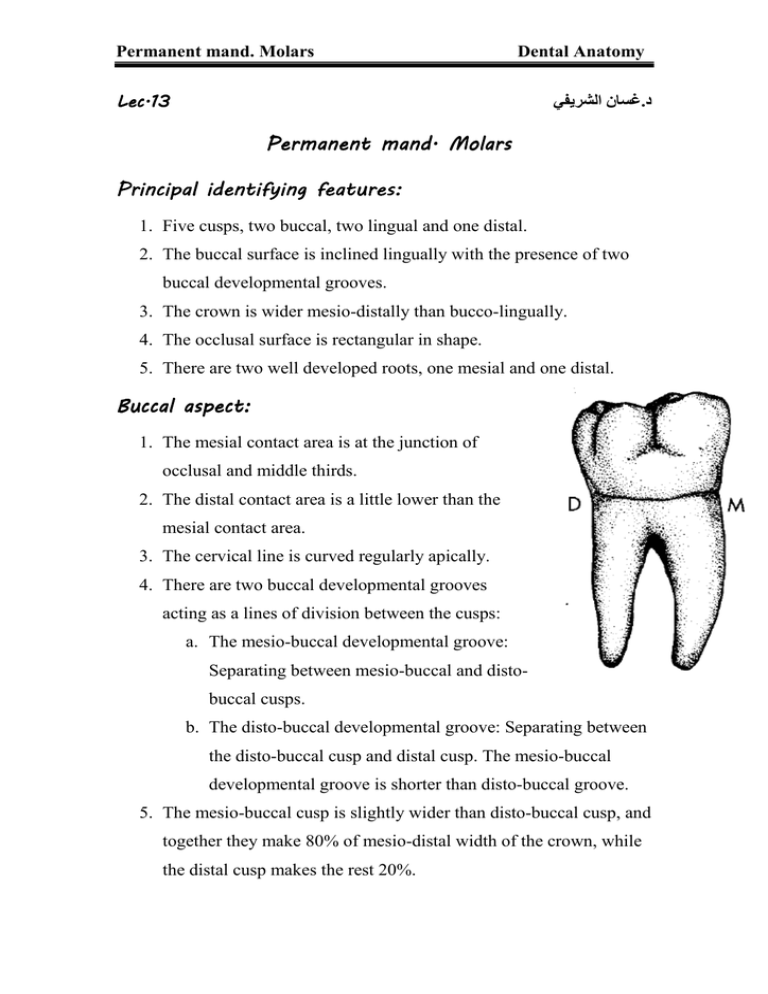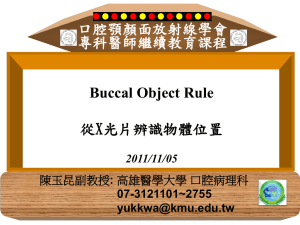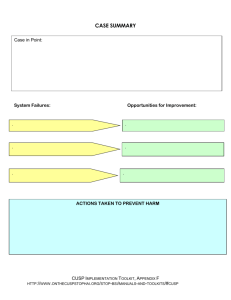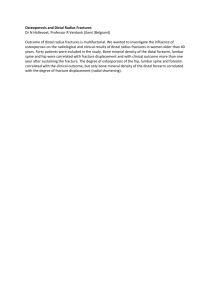Permanent mand. Molars Principal identifying features:
advertisement

Permanent mand. Molars Dental Anatomy غسان الشريفي.د Lec.1 Lec.13 Permanent mand. Molars Principal identifying features: 1. Five cusps, two buccal, two lingual and one distal. 2. The buccal surface is inclined lingually with the presence of two buccal developmental grooves. 3. The crown is wider mesio-distally than bucco-lingually. 4. The occlusal surface is rectangular in shape. 5. There are two well developed roots, one mesial and one distal. Buccal aspect: 1. The mesial contact area is at the junction of occlusal and middle thirds. 2. The distal contact area is a little lower than the mesial contact area. 3. The cervical line is curved regularly apically. 4. There are two buccal developmental grooves acting as a lines of division between the cusps: a. The mesio-buccal developmental groove: Separating between mesio-buccal and distobuccal cusps. b. The disto-buccal developmental groove: Separating between the disto-buccal cusp and distal cusp. The mesio-buccal developmental groove is shorter than disto-buccal groove. 5. The mesio-buccal cusp is slightly wider than disto-buccal cusp, and together they make 80% of mesio-distal width of the crown, while the distal cusp makes the rest 20%. Permanent mand. Molars Dental Anatomy 6. The buccal cusps are flat occlusally, while the distal cusp is rounded. 7. The bifurcation area is about 3mm below the cervical line. Lingual aspect: 1. Three cusps can be seen (mesio-lingual and distolingual and lingual portion of distal cusp), the mesio-lingual is the widest and highest while the distal cusp is the smallest and lowest. 2. The two lingual cusps are pointed and form an obtuse angle at their cusp tips. 3. The lingual developmental groove extends downward for about one third of the crown length and it acts as a line of division between the two lingual cusps. Mesial aspect: 1. The crown is rhomboidal with a lingual tilt of the buccal outline. 2. The buccal outline of the crown is convex from the cervical line up to the junction between the cervical and middle thirds forming the (buccal cervical ridge), then the buccal outline straightens up to the buccal cusp tips. 3. The lingual outline is less convex, with the crest of curvature at the center of middle third. 4. The cervical line is regular, and higher lingually than buccaly. Permanent mand. Molars Dental Anatomy 5. The buccal cusp is flat and the lingual cusp is sharp with greater cusp height. 6. The mesial marginal ridge is located about 1mm below the level of the cusps tips. Distal aspect: 1. The crown is shorter distally than mesially, so most of the occlusal surface can be seen from the distal aspect. 2. The distal cusp is located buccal to the center buccolingually. 3. The distal marginal ridge is short and curves cervically to form an obtuse angle. 4. The cervical line is irregular. 5. The distal root is narrower bucco-lingually than the mesial root. Occlusal aspect: 1. The occlusal outline is rectangular in shape, and is larger mesio-distally than bucco-lingually by 1 mm. 2. The bucco-lingual measurement of the crown is greater on the mesial side than on the distal side, and the mesio-distal measurement of the crown is greater on the buccal side than on the lingual. 3. There are five cusps: mesio buccal (largest), mesio-lingual, distolingual, disto-buccal and distal cusp (the smallest). 4. The distal contact area is located at the distal cusp. 5. There is major fossa which is the central fossa. 6. Minor fossae: Mesial triangular fossa and distal triangular fossa. Permanent mand. Molars Dental Anatomy 7. There are four developmental grooves: (Homework)











